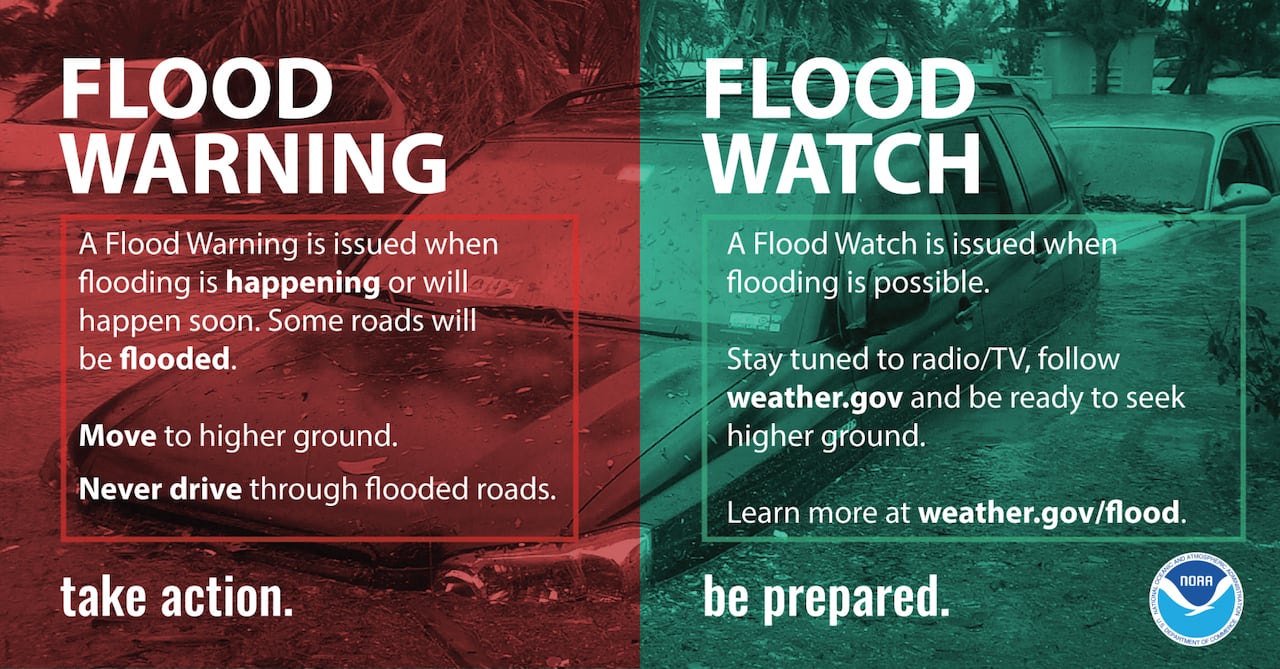Flood Alerts: Your Guide To Safety And Prevention

Table of Contents
Understanding Flood Alerts and Warnings
Different Types of Flood Alerts
Flood alerts are crucial communication tools designed to warn communities about the imminent threat of flooding. However, not all alerts are created equal. Understanding the distinctions between different alert types is essential for an appropriate response.
- Flood Watch: A flood watch signifies that conditions are favorable for flooding to occur. Stay informed and monitor the situation closely. Examples include phrases like "Flood Watch in effect," or "Potential for flash flooding." Action to take: Prepare your emergency kit and family evacuation plan.
- Flood Warning: A flood warning indicates that flooding is happening or is imminent. Take immediate action to protect yourself and your property. Examples include: "Flood Warning issued," "Flooding is occurring," or "Immediate action required." Action to take: Evacuate if instructed, move valuables to higher ground, and seek shelter.
- Flood Advisory: A less severe alert indicating that minor flooding is occurring or is possible. While the risk is lower, it's still important to stay informed and cautious. Examples include "Flood Advisory issued," "Minor flooding possible." Action to take: Monitor the situation, avoid driving through flooded areas, and be aware of potential hazards.
Sources of Flood Alerts
Reliable sources of flood alerts are essential for timely response and effective preparedness.
- National Weather Service (NWS): The primary source for weather-related alerts in many countries. They provide comprehensive information, including watches, warnings, and advisories, and often issue specific flood forecasts.
- Local Emergency Management Agencies: These agencies provide localized alerts and information, tailored to specific communities and geographic areas. They may issue additional warnings based on local conditions.
- Weather Apps: Many reputable weather apps (e.g., AccuWeather, The Weather Channel) provide real-time alerts, often with push notifications, directly to your mobile device. Always ensure the app is from a trusted source.
- National Oceanic and Atmospheric Administration (NOAA): NOAA provides a wealth of resources, including flood maps and data, helping you understand your personal risk.
The reliability of these sources varies; always cross-reference information from multiple sources to get a complete picture. Remember, even if your local area isn't directly mentioned, be aware of general flooding risks in neighboring regions that could indirectly impact you.
Interpreting Flood Alert Information
Understanding the information contained within a flood alert is crucial for proper response. Pay close attention to:
- Affected Areas: Precisely identify areas at risk. Some alerts may cover large regions, while others may focus on specific streets or neighborhoods.
- Potential Impact: The alert may describe the expected severity of flooding, such as minor flooding, significant flooding, or flash flooding.
- Timeframe: Understand the timeframe of the alert—when the threat is expected to begin and end.
For example, an alert might read: "Flood Warning: Flash flooding expected in the Willow Creek area until 10 PM. Seek higher ground immediately." This indicates an immediate and serious threat requiring swift action. Utilizing flood maps and risk assessment tools offered by agencies like the NOAA can further enhance your understanding of potential flooding in your specific area.
Flood Safety and Emergency Procedures
Creating a Family Emergency Plan
Pre-planning is paramount to ensure the safety of your family during a flood. Develop a detailed plan that includes:
- Evacuation Routes: Identify multiple escape routes from your home, considering potential road closures or obstructions.
- Meeting Points: Establish designated meeting points both inside and outside your home, in case family members become separated.
- Communication Strategies: Designate a primary contact person outside your immediate area, and establish methods for communication (text, phone, etc.), in case regular phone lines are disrupted.
- Emergency Kit: Assemble a kit containing essential supplies such as non-perishable food, bottled water, medications, first-aid supplies, important documents, flashlights, batteries, and blankets.
Evacuation Procedures
If a flood warning is issued, evacuating promptly may be necessary.
- Gather Essential Items: Quickly collect your emergency kit, valuables, and important documents.
- Secure Your Home: Turn off utilities (gas, electricity, water) if it's safe to do so. Lock your doors and windows.
- Follow Designated Routes: Use your pre-planned evacuation routes to reach your designated safe location.
- Heed Official Instructions: Follow directions from emergency personnel, and do not attempt to drive through flooded areas.
Staying Safe During a Flood
If evacuation isn't possible, prioritize your safety.
- Seek Higher Ground: Move to the highest level of your home.
- Protect Valuables: Move valuable items to upper floors or waterproof containers.
- Avoid Floodwaters: Never drive or walk through floodwaters; the water may be deeper or faster than it appears, and could contain dangerous debris or contaminants.
- Emergency Contact: If trapped, call emergency services immediately.
Flood Prevention and Mitigation Strategies
Home Floodproofing
Investing in floodproofing measures can significantly reduce the risk of damage to your property.
- Elevate Electrical Systems: Raise electrical panels, wiring, and appliances above the potential flood level.
- Install Flood Barriers: Use sandbags or commercially available flood barriers to protect entrances and openings.
- Waterproof Basements: Apply waterproof coatings to basement walls and floors, and install sump pumps to remove accumulating water.
- Backflow Preventers: Install backflow preventers on sewer lines to prevent sewage backup into your home.
Landscaping for Flood Prevention
Strategic landscaping can help mitigate flood risk:
- Plant Appropriate Vegetation: Trees and shrubs with deep root systems can improve soil drainage and reduce runoff.
- Create Drainage Systems: Install swales or drainage ditches to divert water away from your home.
- Manage Soil Erosion: Proper soil management techniques, including terracing and mulching, prevent soil erosion that can clog drainage systems.
Understanding Your Flood Risk
Knowing your flood risk zone is crucial for implementing appropriate preventative measures.
- Flood Risk Zone Check: Check your property's flood risk zone designation using resources such as the FEMA Flood Map Service Center.
- Flood Insurance: Consider purchasing flood insurance, even if you are not in a high-risk zone.
Conclusion: Be Prepared for Flood Alerts
This guide has highlighted the importance of understanding flood alerts, implementing effective flood safety measures, and taking proactive steps for flood prevention. Remember that preparing for floods is not a one-time event, but rather an ongoing process. By creating a family emergency plan, understanding your risk, and implementing flood prevention strategies, you can significantly reduce your vulnerability to the devastating impacts of floods. Don't wait for a flood alert; take action today to protect your family and home with effective flood prevention strategies. Sign up for flood alerts in your area and invest in the necessary safety and prevention measures to safeguard your future.

Featured Posts
-
 Emmy Winners Daughter And Gerard Butler A Red Carpet Photo
May 26, 2025
Emmy Winners Daughter And Gerard Butler A Red Carpet Photo
May 26, 2025 -
 New How To Train Your Dragon Poster Highlights Toothless And Red Death Size Difference
May 26, 2025
New How To Train Your Dragon Poster Highlights Toothless And Red Death Size Difference
May 26, 2025 -
 Naomi Campbell And Anna Wintour The Alleged Met Gala Ban Explained
May 26, 2025
Naomi Campbell And Anna Wintour The Alleged Met Gala Ban Explained
May 26, 2025 -
 Mathieu Van Der Poel Attacked Paris Roubaix Spectator Confesses
May 26, 2025
Mathieu Van Der Poel Attacked Paris Roubaix Spectator Confesses
May 26, 2025 -
 Matan Angrest Kidnapping Image Surfaces Showing Apparent Wounds
May 26, 2025
Matan Angrest Kidnapping Image Surfaces Showing Apparent Wounds
May 26, 2025
